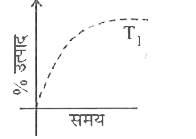For the reaction N2(g)+3H2(g)→2NH3(g),ΔHandΔS are −95.4kJand−198.3J⋅K−1 respectively. Assuming reaction be spontaneous at 500K ? Explain.Solution in Bengali
We know, ΔG=ΔH−TΔS
Given that ΔH=−95.4kJandΔS=−198.3J⋅K−1
∴ΔG=−95.4kJ−500K(−198.3×10−3kJ⋅K−1)
=3.75kJ
As ΔG>0 at 500K, the reaction will not be spontaneous at 500K.
Topper's Solved these Questions
- CHEMICAL THERMODYNAMICSBOOK - CHHAYA PUBLICATIONCHAPTER - CHEMICAL THERMODYNAMICSEXERCISE - SOLVED NCERT EXERCISE
22 Videos
- CHEMICAL THERMODYNAMICSBOOK - CHHAYA PUBLICATIONCHAPTER - CHEMICAL THERMODYNAMICSEXERCISE - HIGHER ORDER THINKING SKILLS (HOTS) QUESTIONS
20 Videos
- CHEMICAL THERMODYNAMICSBOOK - CHHAYA PUBLICATIONCHAPTER - CHEMICAL THERMODYNAMICSEXERCISE - QUESTION ANSWER ZONE FOR BOARD EXAMINATION (SHORT ANSWER TYPE)
35 Videos
- CHEMICAL KINETICSBOOK - CHHAYA PUBLICATIONCHAPTER - CHEMICAL KINETICSEXERCISE - EXERCISE (NUMERICAL PROBLEMS)
37 Videos
- CHEMISTRY IN EVERYDAY LIFE BOOK - CHHAYA PUBLICATIONCHAPTER - CHEMISTRY IN EVERYDAY LIFE EXERCISE - PRACTICE SET 15
15 Videos
Similar Questions
A thermodynamics state function is a quantity-
View SolutionThe results obtained by applying the mathematical form of the first law of thermodynamics for different process are given below. Identify the process (w=P-V work only): ΔU=0,q+w=0
View SolutionAccording to the definition of thermodynamic system, which system does living beings belong to, and why?
View Solution2A→4B+D , in this reaction, concentration of B increases to 2×10−3mol.L−1 after 10s from the start of the reaction . Calculate : rate of formation of B
View SolutionWhich will not enhance nutritional value of food-
View SolutionFor the reaction : N_(2(g))+3H_(2(g))hArr2NH_(3(g)) , DeltaH=-ve , the correct statement is :
View SolutionCalculate the standard free energy change for the reaction,
N2(g)+3H2(g)→2NH3(g)at298K.
Given, ΔH∘=−92.4kJ and ΔS∘=−198.3JK−1. Also, comment on the result.
View SolutionFor reaction, N_(2(g))+3H_(2(g))to2NH_(3(g)) , DeltaH=-95.4kJ and DeltaS=-198.3JK^(-1) . Calculate the maximum temperature at which the reaction will proceed in forward direction.
View SolutionFor the reaction
N2(g)+3H2(g)⇔2NH3(g),ΔH=?
View SolutionIn a reaction N_(2(g))+3H_(2(g))to2NH_(3(g)) rate of appearance of NH_(3) is 2.5xx10^(-4)molL^(-1)sec^(-1) then rate of reaction and rate of disappearance of H_(2) respectively is :-
View SolutionFor this reaction N_(2(g))+3H_(2(g))to2NH_(3(g)) The relation between (d(NH_(3)))/(dt) and -(d(H_(2)))/(dt) is :-
View SolutionFor the reaction N_(2)(g)+3H_(2)(g)to2NH_(3)(g) , which of the following is correct regarding DeltaH ?
View Solutionअभिक्रिया N2(g)+3H2(g)→2NH3g के लिए 298 K पर एंथैल्पी परिवर्तन ΔH−92.38KJ है। इसी ताप पर ΔE का मान ज्ञात करें।
View Solutionअभिक्रिया N2(g)+3H2(g)→2NH3(g) के लिए हाइड्रोजन के सन्दर्भ में अभिक्रिया का वेग क्या होगा?
View Solutionअभिक्रिया N2(g)+3H2(g)↔2NH)(3(g)),ΔH<0 में अमोनियम के उत्पाद की समय पर निर्भरता (P, T1) पर नीचे दर्शायी गयी है।

View Solution
